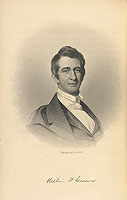![]()
William Seward, ca. 1853. Engraving.
![]()
William Seward
![]()
William Seward (1801-1872), of Auburn, New York, served as governor of
New York from 1838 to 1842. He was elected to the U.S. Senate as a Whig
party member in 1847, primarily because of his anti-slavery stance. He
fought a hard political battle against the Missouri Compromise of 1850
and in favor of the admission of California as a free state.
Seward later softened his stance on slavery to appease Southerners during his unsuccessful run for president on the Republican ticket. Lincoln made Seward his Secretary of State, and called upon Seward to help compose the Emancipation Proclamation. Seward also sheltered slaves on the Underground Railroad. He admired the work of Harriet Tubman, and sold her the land in Auburn, New York, where she built her home.
![]()
- William Lloyd Garrison
- Wendell Phillips
- Lydia Maria Child
- Samuel J. May
- Lucretia Mott
- Sojourner Truth
- Lewis Tappan
- William Seward
- Frederick Douglass
- Gerrit Smith
- Pennsylvania Hall
| |
| |
| |
| |
| |
| |
| |
| |
| |
| |
| |
| |

Copyright © 2002 Division
of Rare & Manuscript Collections
2B Carl A. Kroch Library, Cornell University, Ithaca, NY, 14853
Phone Number: (607) 255-3530. Fax Number: (607) 255-9524
For reference questions, send mail to:
rareref@cornell.edu
For questions or comments about the site, send mail to: webmaster.
